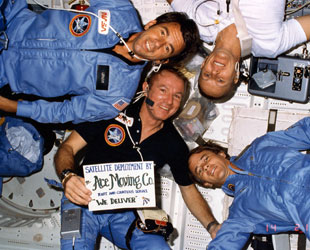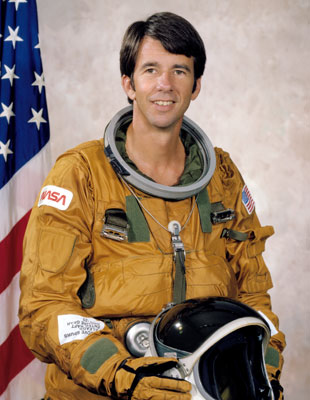This article was updated on Aug. 30, 2010. It was updated to correct the date of Lenoir's passing based on information received from his family.
August 29, 2010 — Former NASA astronaut William "Bill" Lenoir, who flew aboard the first operational mission of the space shuttle in November 1982, died at age 71.
According to family members, Lenoir died Thursday, Aug. 26 after suffering head injuries during a bicycle accident earlier that day.
Lenoir, who was selected by NASA for its sixth astronaut group and second class of "scientist-astronauts" in 1967, did not fly in space until 15 years later as a member of the STS-5 crew.
The STS-5 space shuttle mission in 1982 was the fifth for orbiter Columbia and the first considered operational after four test flights. The mission launched with two satellites and four crewmembers, including Lenoir. It was the largest crew for a spaceflight at the time.
Lenoir served during the Nov. 11, 1982 launch as the first flight engineer, aiding commander Vance Brand and pilot Robert Overmyer from his seat on Columbia's flight deck. Five days later, when it came time to return to Earth, he traded places with fellow mission specialist Joseph Allen, becoming the first to experience a shuttle reentry from the orbiter's middeck.
Lenoir and Allen were scheduled to establish another first together -- the first spacewalk from the shuttle -- but after being delayed a day due to Lenoir becoming ill, the outing was canceled due to mechanical issues with both of their spacesuits.

Bill Lenoir and his STS-5 crewmates display a sign advertising satellite deployment by the "Ace Moving Company." (NASA) |
The mission successfully deployed its two communication satellites, the first commercial shuttle payloads, leading to the crew displaying a sign dubbing themselves the "Ace Moving Company" with the motto, "We Deliver."
Landing on Nov. 16 at Edwards Air Force Base, California, Lenoir and his three crewmates had logged more than 2.1 million miles. For Lenoir, their 81 orbits would be his only spaceflight experience.
Lenoir was offered another mission, the STS-61A flight in October 1985 that flew the German-managed D1 Spacelab aboard orbiter Challenger, but he ultimately declined citing the time that training would require he would be away from his family and his desire to start a new career.
Lenoir left NASA's astronaut corps in September 1984 to join the aerospace management and consulting firm Booz Allen Hamilton of Bethesda, Maryland.
He returned to the space agency five years later however, becoming Associate Administrator for Space Flight under NASA Administrator and fellow astronaut Richard Truly.
For three years, Lenoir oversaw all U.S. manned missions from the third shuttle flight to follow the loss of Challenger through the maiden mission of orbiter Endeavour.
Leaving NASA for a second and last time, Lenoir rejoined Booz Allen Hamilton in 1992 as Vice President for Applied Systems. He remained in that position for eight years until his retirement in April 2000.

William "Bill" Lenoir's portrait taken prior to STS-5. (NASA) |
William Benjamin "Bill" Lenoir was born March 14, 1939 in Miami, Florida, which would later establish him as the first native-born Floridian astronaut. A descendant of General William Lenoir, a Revolutionary War officer, he developed an early interest in math and science.
He earned his bachelor's, master's, and doctorate degrees in electrical engineering from the Massachusetts Institute of Technology, where he also taught, first as an instructor and then as an assistant professor.
In 1965 while at MIT, Lenoir also worked as a researcher and investigator on Apollo Application experiments, which would evolve into the Skylab space station. Joining NASA two years later, he would continue this work from inside the agency.
For the decade and a half between his being selected as an astronaut and his flying in space, Lenoir served as a back-up crew member for the second and third missions to Skylab, coordinating solar observations for the latter as capcom, and later leading NASA's Satellite Power Team, investigating the potential of adapting large-scale space power systems for use on Earth.
Beginning in 1976, he was involved in the development of the space shuttle, in the areas of orbit operations, training, extravehicular activity (also known as spacewalking), and payload deployment and retrieval.
Lenoir also completed a 53-week flight training course at Laughlin Air Force Base in Texas, ultimately logging over 3,000 hours of flying time in jet aircraft.
A recipient of the NASA Exceptional Service Medal and NASA Space Flight Medal, Lenoir was a senior member of the Institute of Electrical and Electronics Engineers and the winner of the Carleton E. Tucker Award for Teaching Excellence at MIT.
Twice married, first to Elizabeth May Frost, whom he met as an undergraduate, and then Terri Waite, a retired NASA engineer, Lenoir is survived by three grown children.
